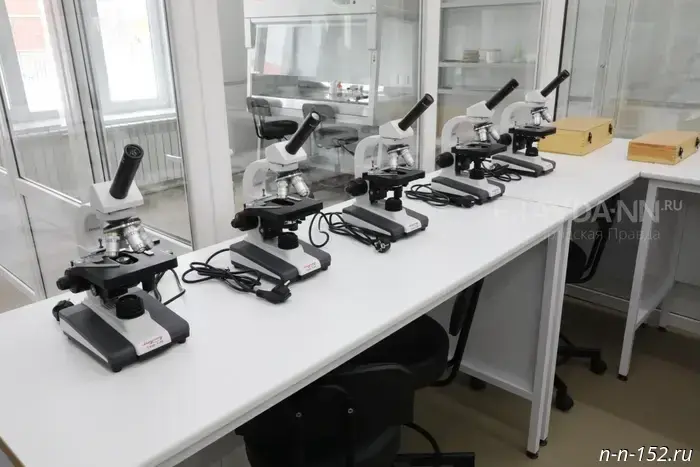A tasting of our city's architecture
The publishing house TATLIN has released an architectural map-guide “Dzerzhinsk 1920s–1990s. Archimap.” The edition was produced with the support of SIBUR, the tourist center “Meet Nizhny” and the Tikhaya studio. A brochure titled “Architecture of Dzerzhinsk. Tasting Set” was released alongside the map. Their presentation took place on July 30 at the Tikhaya studio in Nizhny Novgorod. The next day the project was presented to residents and journalists of Dzerzhinsk during a walk along the pedestrian routes of the guide.
Gastronomic Angle
Ivan Sapogov
The tour of the architectural highlights of our city was led by the publication’s author Ivan Sapogov and Konstantin Antipin, author of the Telegram channel “Architectural Excesses.” Ivan Sapogov is a young but already fairly well-known historian of architecture from the Moscow region in the domestic art history community. Dzerzhinsk Vedomosti covered his work in our city. Ivan admitted that he had fallen in love with Dzerzhinsk’s architecture and hopes to continue his scholarly research.
The map-guide gathers six walking routes and one cycling route — to the Shukhov tower. The walking routes are thematic: “From the Arch to the Fire Station,” “Small Ring,” “Large Ring,” “Panels and Mosaics,” “Late Modernism,” “The Settlement Named After Y.M. Sverdlov.” All 57 sites marked on the map are illustrated with photographs, with construction dates and project authors indicated.
“The map is an attempt to integrate into Dzerzhinsk a person who knows absolutely nothing about the city,” noted artist and director of the Tikhaya studio Artem Filatov.
The map is complemented by the brochure “Architecture of Dzerzhinsk. Tasting Set,” which tells the story of Soviet avant-garde architecture and helps to comprehend monumental art through delicate culinary metaphors. The unusual presentation is very contemporary: the authors want to explain complex architectural moments through the language of gastronomic refinement.
“We seized on Ivan Sapogov’s idea that Dzerzhinsk is a tasting set of Michelin level. (‘Michelin’ is the ranking of the world’s best culinary establishments compiled by the French travel guide Michelin — note by S.A.),” continues Artem Filatov. “On the one hand, it’s a gentle irony toward Dzerzhinsk, and on the other, an acknowledgment of the vicissitudes connected with the history of architecture.”
Silicate Brick and Buckwheat
Sapogov believes that the almost century-old architectural appearance of our city can be characterized as “silicate brick with a sauce of ceramic patterns.” In Ivan’s opinion, silicate brick — Dzerzhinsk’s main material — is like buckwheat. It is, like the principal Soviet cereal, unpretentious. Its production does not require complex equipment or expensive materials. “Soviet silicate ornamentation, laid with red brick against gray, even by its color resembles carrot sauces peeking through a gray mass of buckwheat,” Sapogov writes. Moreover, words and symbols made of brick often turn out to be the folk art of Soviet masons, not averse to independent creativity. Undoubtedly, builders did not always “do as they pleased.” For example, the mosaic on the relief “Water World” on the façade of the Zarya swimming pool is a rare, complex, very expensive and beautiful technique executed according to a pre-agreed artistic design.
Doll-like Kalmykov
The building of the former Udarnik cinema was designed by the well-known Moscow architect Viktor Kalmykov.
“Kalmykov built almost all the cinemas in the USSR; in the 1930s he erected them in batches,” says Ivan Sapogov. “Dzerzhinsk’s ‘Udarnik’ is the ‘smallest Kalmykov’ I know. Here he applied his signature device — two little towers. But what charms me, for instance, is that the towers are so small, almost doll-like.”
The city administration building is also an architectural monument. Sapogov calls it, in the Soviet tradition, the gorispolkom (city executive committee):
“The gorispolkom is the work of the architect Grinberg, a major Moscow constructivist. The forms of this building had some influence on the formation of Soviet modernism.”
Stalians from Kusakin’s Warehouse
Two other buildings on Dzerzhinsky Square — the former Oka restaurant and the former department store (now the Chamber of Commerce and Industry) — were designed by Dzerzhinsk’s chief architect of the 1940s–50s, Alexey Kusakin. Sapogov calls the two Kusakin masterpieces “Stalians” or ceremonial Soviet cuisine.
“The swollen edge leaves against the background of the capital — that’s the peak of Stalinist architecture; it swelled from the life juices flowing through it. I call it the strange word ‘Stalians,’” says Ivan. “If you look at the Chamber of Commerce and Industry building, you can see that it is very Baroque. It has little relation to classicism. Architecture is a warehouse of materials from which you can take whatever is poorly stored — Kusakin wrote this in his memoirs. And he not only wrote it, he also shaped elements of his architecture: he took from the warehouse whatever he wanted.”
Peculiarity in Roundness
On Lenin Avenue another masterpiece of early Soviet avant-garde in red silicate brick hides.
“The building of the Red Army Technical School is a powerful piece of architecture,” admires Ivan Sapogov and unexpectedly continues, “its peculiarity lies in its roundness. Here you can observe several starting points of modern architecture as formulated by the famous French architect Le Corbusier. Ribbon glazing, a free façade, a flat roof. Three out of four features are present. We can see that a building must not submit to symmetry, must not have windows where we are used to seeing them… It’s still a question who influenced whom more — the avant-gardists on Le Corbusier or he on them? The Soviet avant-garde is our contribution to the treasury of world civilization. All modern architecture as we know it is charged with the spirit of experimentation of Soviet architecture of the 1920s–30s.”
The “House on Legs”
The next stop on the tour is the former dormitory in Uchebny Lane. Unlike other architectural monuments located in the city center that residents see almost every day, this constructivist-era monument is hidden in a courtyard on the city’s edge, and very few people know of the existence of this art object. The building was restored several years ago.
“Here we see column supports. Le Corbusier believed that modern buildings should ‘stand on legs,’” comments Ivan Sapogov. “In any case, in Dzerzhinsk almost a century ago an unknown architect paid homage to the then-modern tendencies in architecture. Here an imitation rustication of masonry already appears as a decorative element, which was initially alien to avant-garde architecture. This is rather one of the traits of post-constructivist architecture.”
Sergey ANISIMOV. Photos by the author and Anastasia Ponomareva
First-Person Account
Dmitry Shadymov, head of the “Corporate Communications” division at SIBUR-Neftekhim:
“Publishing the map-guide is not only an opportunity to look anew at Dzerzhinsk’s architectural heritage, but also an important step in the development of cultural tourism in the region. Thanks to the support of SIBUR and partners, residents and visitors now have a unique tool for studying history through the prism of architecture. In the future, a series of excursions and educational events are planned, which will help to delve even deeper into the context of Soviet modernism and the avant-garde. For now — take the map in your hands, choose a route and set off to meet the unexpected Dzerzhinsk.”
Другие Новости Нижнего (Н-Н-152)
 Nizhny Novgorod State University will study an unknown gene linked to autism and intellectual disability.
Scientists from Nizhny Novgorod State University named after N.I. Lobachevsky (NNSU) are beginning research into one of the little-studied genes potentially linked to the development of autism and intellectual disability. August 10, 2025. Nizhegorodskaya Pravda. Nizhny Novgorod Region. Nizhny Novgorod.
A Saratov resident was killed when debris from a drone fell in the yard of a residential building.
A Saratov resident died when fragments of a UAV fell in the yard of a residential building.
According to Governor Roman Busargin, residents of three apartment buildings were evacuated after UAV fragments fell in one of Saratov’s yards. 10.08.2025. NTA-Privolzhye. Nizhny Novgorod Oblast. Nizhny Novgorod.
Nizhny Novgorod State University will study an unknown gene linked to autism and intellectual disability.
Scientists from Nizhny Novgorod State University named after N.I. Lobachevsky (NNSU) are beginning research into one of the little-studied genes potentially linked to the development of autism and intellectual disability. August 10, 2025. Nizhegorodskaya Pravda. Nizhny Novgorod Region. Nizhny Novgorod.
A Saratov resident was killed when debris from a drone fell in the yard of a residential building.
A Saratov resident died when fragments of a UAV fell in the yard of a residential building.
According to Governor Roman Busargin, residents of three apartment buildings were evacuated after UAV fragments fell in one of Saratov’s yards. 10.08.2025. NTA-Privolzhye. Nizhny Novgorod Oblast. Nizhny Novgorod.
 Scammers conned a pensioner from Dzerzhinsk out of more than a million rubles.
Nizhny Novgorod News
Scammers conned a pensioner from Dzerzhinsk out of more than a million rubles.
Nizhny Novgorod News
 Trichologist Varenova told residents of Nizhny Novgorod about the harm beer-based hair masks can cause.
Nizhny Novgorod News
Trichologist Varenova told residents of Nizhny Novgorod about the harm beer-based hair masks can cause.
Nizhny Novgorod News
 An employee of the Nizhny Novgorod branch of Rosseti Center and Privolzhye climbed Mount Elbrus.
Photo: Vladislav Talanov
Vladislav Talanov, an engineer in the electricity metering and loss optimization department of the Rosseti Centre and Privolzhye branch — Nizhnovenergo, conquered the highest mountain peak in Russia and Europe — the western 09.08.2025. Vremya N. Nizhny Novgorod Region. Nizhny Novgorod.
An employee of the Nizhny Novgorod branch of Rosseti Center and Privolzhye climbed Mount Elbrus.
Photo: Vladislav Talanov
Vladislav Talanov, an engineer in the electricity metering and loss optimization department of the Rosseti Centre and Privolzhye branch — Nizhnovenergo, conquered the highest mountain peak in Russia and Europe — the western 09.08.2025. Vremya N. Nizhny Novgorod Region. Nizhny Novgorod.
A tasting of our city's architecture
TATLIN publishing house has released the architectural map-guide "Dzerzhinsk 1920s–1990s. 10.08.2025. Dzerzhinsk Gazette. Nizhny Novgorod Region. Dzerzhinsk."
